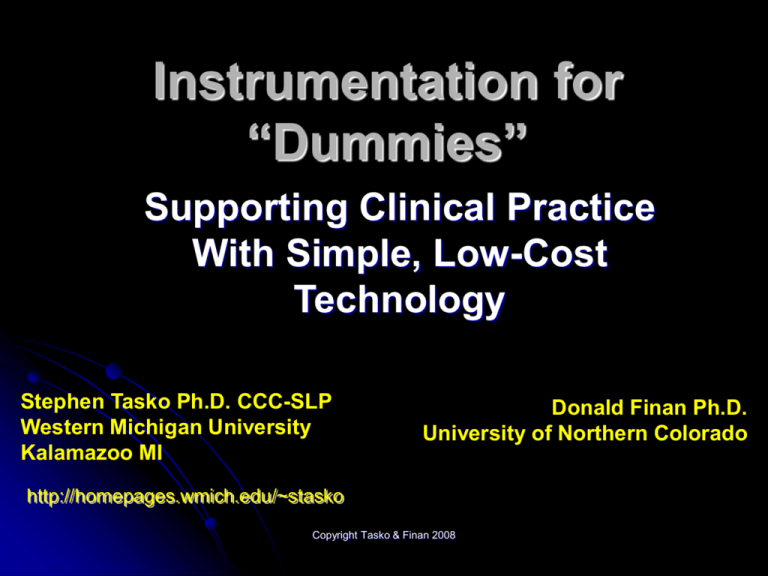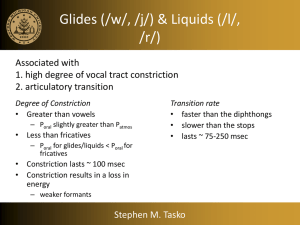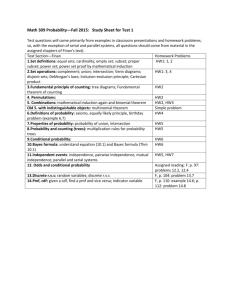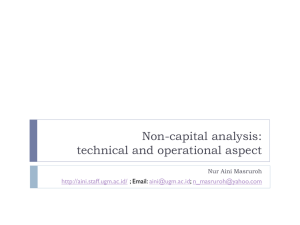Instrumentation for “Dummies”
advertisement

Instrumentation for “Dummies” Supporting Clinical Practice With Simple, Low-Cost Technology Stephen Tasko Ph.D. CCC-SLP Western Michigan University Kalamazoo MI Donald Finan Ph.D. University of Northern Colorado http://homepages.wmich.edu/~stasko Copyright Tasko & Finan 2008 Topics Why focus this talk on high quality sound recording? Sound recording 101 Available recording devices Copyright Tasko & Finan 2008 Instrumentation and Technology Love it or hate it? Copyright Tasko & Finan 2008 Why focus discussion on sound recording? High quality digital recordings can now be made with fairly common devices at relatively low costs In my view, as both a speech language pathologist and speech scientist, good sound recordings give the SLP the most “bang for the buck” Copyright Tasko & Finan 2008 What high quality digital sound recording offers? Provides a permanent archive of client behavior Can allow quick, easy access to samples to monitor client status Has face validity Potential for more objective baseline and follow up evaluation Can support and guide clinical decision making Can serve to streamline and standardize assessment approaches Allows an entrée into More quantitative instrumented analysis Database development for clinician directed research on outcomes Copyright Tasko & Finan 2008 Sound Recording 101 Copyright Tasko & Finan 2008 Tasko’s rating system Preferable Highly preferred Not recommended Strongly discouraged Copyright Tasko & Finan 2008 Sound Frequency ranges Normal humans hearing 20 Hz – 20,000 Hz Human speech ~ 50 Hz – 8000 Hz Standard phone circuits ~ 300 - 3000 Hz Copyright Tasko & Finan 2008 Frequency Range for Speech For good audibility, we need to be sure our recordings capture the whole frequency range for speech Copyright Tasko & Finan 2008 What are you using the recording for? Copyright Tasko & Finan 2008 Components of Sound Recording microphone Pre-amplifier (maybe) Copyright Tasko & Finan 2008 Cassette recorder Components of Sound Recording microphone Pre-amplifier (maybe) Copyright Tasko & Finan 2008 or The quality of the recording is only as good as its weakest component Copyright Tasko & Finan 2008 Components of Sound Recording Microphone +/- amplifier Digital Recording Device •Digitization of sound •Storing of sound as file Copyright Tasko & Finan 2008 Playback ability •Amplifier-Speaker •Headset How does tape recording differ from digital recording? Analog (tape) recording Acquires a continuously varying signal Digital recording Acquires a string of discrete numbers Copyright Tasko & Finan 2008 2 1.5 Sound Pressure 1 0.5 0 -0.5 Analog (Continuous) -1 -1.5 -2 Time 2 1.5 Sound Pressure 1 0.5 0 Digital (Discrete) -0.5 -1 -1.5 -2 Time Copyright Tasko & Finan 2008 Digital Recording Since sound is converted to a string of numbers, two issues have an influence on recording accuracy/fidelity 1. How often does the device “grab” a number? Sampling rate/frequency 2. How much precision is used when number recording? Quantization level Copyright Tasko & Finan 2008 Sampling Rate 2 1.5 Sound Pressure 1 0.5 High 0 -0.5 -1 -1.5 -2 Time 2 1.5 Sound Pressure 1 0.5 0 -0.5 -1 -1.5 -2 Time 2 1.5 Sound Pressure 1 0.5 0 -0.5 -1 -1.5 Copyright Tasko & Finan 2008 -2 Time Low Sampling Theorem If a band-limited signal is sampled at a rate that is at least twice as high as the highest frequency in the signal, no information is lost and the original signal can be exactly reconstructed from the samples Copyright Tasko & Finan 2008 Nyquist frequency Maximum frequency contained in the signal of interest Humans hear < 20 KHz Human speech < 7-8 KHz Phone circuits < 3.2 KHz Copyright Tasko & Finan 2008 Simple Rule sample rate/frequency must be 2X highest frequency of interest For speech it must be at least 16000 Hz Copyright Tasko & Finan 2008 Digital Devices: Common sample rates 5,562 Hz 32 KHz 11,025 Hz 16 KHz 8 KHz 22,050 Hz 4 KHz 2 KHz 44,100 Hz CD quality Captures range of hearing Copyright Tasko & Finan 2008 Problems associated with poor selection of sample rate Loosing important parts of the “bandwidth” Possibility of “aliasing” F= 7 KHz SF=16KHz F=7 KHz SF=8 KHz Most sound cards have anti-aliasing filters Low-pass filters sound to prevent aliasing However, now have a restricted bandwidth TAKE-HOME MESSAGE DO NOT UNDERSAMPLE YOUR SIGNAL http://www.dsptutor.freeuk.com/aliasing/AliasingDemo.html Copyright Tasko & Finan 2008 Quantization 2 1.5 Sound Pressure 1 0.5 0 -0.5 -1 -1.5 -2 Time millimeters more precise Inches less precise Copyright Tasko & Finan 2008 Quantization 2 1.875 1.75 1.625 1.5 1.375 1.25 1.125 1 0.875 0.75 0.625 0.5 0.375 0.25 0.125 0 -0.125 -0.25 -0.375 -0.5 -0.625 -0.75 -0.875 -1 -1.125 -1.25 -1.375 -1.5 -1.625 -1.75 2 -1.875 -2 High 1.75 0 2 4 6 8 10 12 14 16 18 20 0 2 4 6 8 10 12 14 16 18 20 0 2 4 6 8 10 12 14 16 18 20 1.5 1.25 1 0.75 0.5 0.25 0 -0.25 -0.5 -0.75 -1 -1.25 -1.5 -1.75 2 -2 1.5 1 0.5 0 -0.5 -1 -1.5 -2 Copyright Tasko & Finan 2008 Low Quantization Expressed in “bits” ↑ bits ~ ↑ # of marks on the “ruler” = greater precision X bits/sample = 2x possible units of measure For example, 2 bit = 4 levels 4 bit = 16 levels 8 bit = 256 levels 12 bit=4096 levels 16 bit = 65536 levels http://www.cosc.canterbury.ac.nz/mukundan/covn/Quant.html Copyright Tasko & Finan 2008 Quantization Expressed in “bits” ↑ bits ~ ↑ # of marks on the “ruler” = greater precision X bits/sample = 2x possible units of measure For example, 2 bit = 4 levels 4 bit = 16 levels 8 bit = 256 levels 12 bit=4096 levels 16 bit = 65536 levels Copyright Tasko & Finan 2008 2 1.5 1 Low sampling rate 0.5 0 0.5 Low quantization -1 1.5 -2 0 2 1.875 1.75 1.625 1.5 1.375 1.25 1.125 1 0.875 0.75 0.625 0.5 0.375 0.25 0.125 0 0.125 -0.25 0.375 -0.5 0.625 -0.75 0.875 -1 1.125 -1.25 1.375 -1.5 1.625 2 -1.75 1.875 -2 0 1.5 2 4 6 8 10 12 14 16 18 20 Low sampling rate High quantization 2 4 6 8 10 12 14 16 18 20 1 0.5 High sampling rate 0 -0.5 -1 -1.5 Low quantization Checking your own computer Copyright Tasko & Finan 2008 Sound Fidelity vs. File Size Digital memory is relatively cheap Good client records are invaluable Copyright Tasko & Finan 2008 Components of Sound Recording Microphone +/- amplifier Digital Recording Device •Digitization of sound •Storing of sound as file Copyright Tasko & Finan 2008 Playback ability •Amplifier-Speaker •Headset Digital File formats Mono vs. Stereo Alphabet Soup .wav .nsp .mp3 .mp4 .wma .dss .au etc, etc, etc Copyright Tasko & Finan 2008 Digital File formats Uncompressed Formats (Lossless) All samples are retained What you record is what you get Most common format “.wav” (PCM) Compressed Formats algorithm used to reduce file size yet maintain good audibility Driven, in part, by music industry Common Formats .mp3, .wma, .dss Effect on speech samples is not well known Copyright Tasko & Finan 2008 Components of Sound Recording Microphone +/- amplifier Digital Recording Device •Digitization of sound •Storing of sound as file Copyright Tasko & Finan 2008 Playback ability •Amplifier-Speaker •Headset The Microphone Microphones Matter!! Copyright Tasko & Finan 2008 What (I think) you need to know about microphone selection Type of microphone Underlying operation How it connects to other devices Pick up patterns Frequency Response Copyright Tasko & Finan 2008 Microphones: Common Types Handheld Clip on/lavalier Head worn Built in to recorder Copyright Tasko & Finan 2008 Underlying operation Copyright Tasko & Finan 2008 Copyright Tasko & Finan 2008 Copyright Tasko & Finan 2008 Copyright Tasko & Finan 2008 Headset Microphone Placement Copyright Tasko & Finan 2008 Microphone Frequency Response What is a frequency response curve? Graph that shows how the microphone responds over a range of frequencies Look for a relatively flat line within the frequency range for speech Copyright Tasko & Finan 2008 Frequency Response Curve Copyright Tasko & Finan 2008 Frequency Response Curve Speech Range Copyright Tasko & Finan 2008 Frequency Response Curve Copyright Tasko & Finan 2008 To pre-amplify or not to pre-amplify Great variation in size of signal coming from mics May need to amplify the mic signal so it is heard by the recording device Often Best mics put out small signals Cheapest mics put out largest signals Copyright Tasko & Finan 2008 A Tasko Seal of Approval Audio-Technica ATM75 (without powerpack!! - cheaper) Features Condensor type Headworn Directional Acceptable frequency response Decent sized output signal amplification not typically necessary Can be purchased with a variety of connectors REASONABLY PRICED (~ $99) Copyright Tasko & Finan 2008 Audio Technica ATM75 http://www.soundprofessionals.com/cgi-bin/gold/item/ATM75-SP-NP Copyright Tasko & Finan 2008 Recording Issues Keep mic-mouth distance relatively constant within and across recording sessions Setting your recording levels is very important You really want a device that monitors the recording level Copyright Tasko & Finan 2008 Apply the “Goldilocks” Rule Copyright Tasko & Finan 2008 That recording level is just tooooo low! Environmental noise becomes an issue Does not take advantage of the precision of the recording device 2 1.5 0.5 2 1. 5 1 Sound Pressure Sound Pressure 1 0 0. 5 0 -0. 5 -1 -1. 5 -0.5 -2 Time -1 -1.5 -2 Copyright Tasko & Finan 2008 Time Signal will be “clipped” 1.5 resulting in distortion 2 Truncates the largest amplitude 1 1.5 components 1 0.5 0 -0.5 -1 -1.5 -2 Sound Pressure Sound Pressure That recording level2 is just tooooo high! 0.5 0 -0.5 Copyright Tasko & Finan 2008 -1 Components of Sound Recording Microphone +/- amplifier Digital Recording Device •Digitization of sound •Storing of sound as file Copyright Tasko & Finan 2008 Playback ability •Amplifier-Speaker •Headset A brief survey of digital recording devices Personal Recording Devices “Professional” Grade Devices Digital dictaphones iPods PDAs (Palms, Smartphones) Digital equivalents to the pro-duty cassette recorders Devices developed primarily for music industry The PC (or Mac) Laptop Desktop Copyright Tasko & Finan 2008 Questions to ask about portable recording devices Basic recording performance questions Are the sampling rate options appropriate for speech recording? Is the quantization rate appropriate for speech recording? Is the overall frequency response of the device acceptable for speech recording? Copyright Tasko & Finan 2008 Questions to ask about portable recording devices Microphone/recording level related questions Can an external microphone be used? What kind of connectors are needed? Will you need a mic amplifier? Can recording levels be adjusted? Can recording levels be monitored? Copyright Tasko & Finan 2008 Questions to ask about portable recording devices Data Storage/Transfer Questions What file format is used to save the data? Can it record in a lossless format? What is the recording capacity of the system with the preferred recording settings? Does it have only built in memory or can you use standard memory media (e.g. SD cards)? How easy is it to move the recordings off the device and onto a PC for archiving (i.e. USB)? Copyright Tasko & Finan 2008 Questions to ask about portable recording devices Human Factors Questions Can you easily play back recordings? What is quality of device playback? Is it easy to use? Is it too big or small? … Copyright Tasko & Finan 2008 Personal Recording Devices Digital dictaphones iPods PDAs (Palms, Smartphones) Many have good specifications File format options can be quite limited Often have serious limitations regarding microphone/recording level flexibility Copyright Tasko & Finan 2008 Dictaphones Copyright Tasko & Finan 2008 Other options: iPod Copyright Tasko & Finan 2008 Personal Recording Devices Copyright Tasko & Finan 2008 “Professional” Grade Devices Greater flexibility in all areas Minimize concerns about digitization specs Typically use a .wav (uncompressed) format Larger and sometimes bulky Can be quite expensive Good values if you look at devices designed for the music industry Copyright Tasko & Finan 2008 Professional Duty Marantz PMD660 ~ $500 Copyright Tasko & Finan 2008 Professional Duty Boss Micro BR ~ $230 Don Finan’s Seal Of Approval Copyright Tasko & Finan 2008 Professional Duty M-Audio Microtrack < $300 Copyright Tasko & Finan 2008 A Significant Disadvantage of Recording with Portable Devices ↑↑ Housekeeping duties Sound recording file management Naming files so you know what is in them Moving files from device or portable media to a more permanent archive (PC, CD) Finding software to replay the files you’ve acquired Copyright Tasko & Finan 2008 PC Based Recording Copyright Tasko & Finan 2008 Free (yes, free) software for recording/analyzing high quality speech signals Speech Tool SFSWin (UCL Phonetics Lab) Alvin Wavesurfer Praat Audacity Copyright Tasko & Finan 2008 Issues with PC recording Not all PC sound cards are identical Vast majority work perfectly well Occasional problems include Noise or static Shifts in recording baseline (does not affect how it sound) Copyright Tasko & Finan 2008








